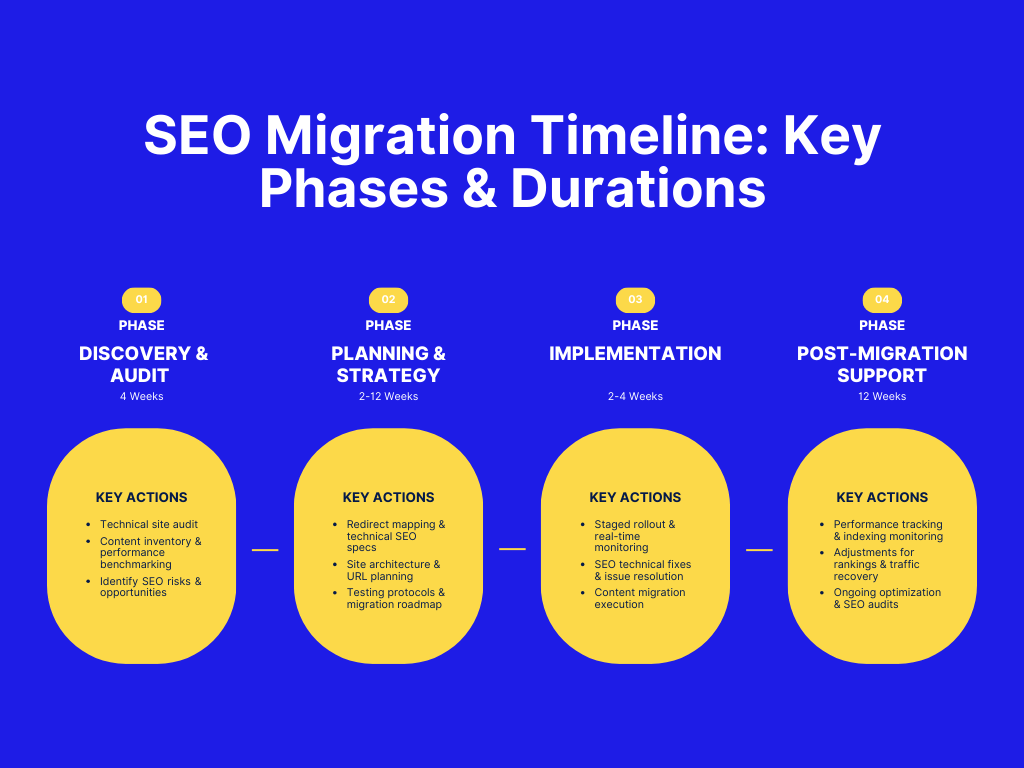
How Long Does An SEO Site Migration Take? Mastering Timelines for a Hassle-Free Site Migration
A website migration without proper SEO planning often leads to devastating consequences. Within 24 hours of migration, organic traffic can plummet by 90%, years of SEO progress can vanish, and revenue streams can dry up overnight. The reason? Many businesses treat SEO as an afterthought rather than a crucial component of the migration process.
Understanding migration timelines is essential for preserving your digital presence. When you migrate a website, you’re not just moving content from one place to another – you’re carefully preserving years of accumulated SEO value, maintaining search visibility, and ensuring business continuity throughout the transition.
Why SEO Is Crucial for a Successful Migration?
Understanding the SEO Migration Process
Think of your website’s SEO value as a complex network of digital relationships. Your domain authority, backlinks, and rankings are like a web of connections you’ve built over years. When you migrate your site, you’re not just moving content – you’re carefully transplanting this entire ecosystem.
The migration process involves several critical components that directly impact your search visibility:
- Comprehensive redirect mapping to preserve link equity
- Technical configuration to maintain search engine access
- Content preservation to protect keyword rankings
- URL structure planning to maintain site hierarchy
Whether you’re changing domain names, switching CMS platforms, or completely overhauling your site architecture, each element requires careful consideration and precise execution.
Common Pitfalls of Ignoring SEO During Site Migration
The consequences of overlooking SEO during migration can be severe and long-lasting. Here are the three most critical impacts:
Immediate Ranking Drops: Without proper redirect mapping, search engines lose the ability to associate your old content with your new URLs. This results in immediate ranking losses across your keyword portfolio, effectively erasing years of SEO progress overnight.
Revenue Impact: When organic traffic drops, the impact ripples through your entire business. E-commerce sites lose sales, lead generation dries up, and marketing budgets need emergency reallocation to compensate for the loss in organic performance.
Extended Recovery Time: Even with immediate corrective action, recovery isn’t instant. Search engines need time to recrawl and reindex your site, understand the new structure, and rebuild trust signals. This process typically takes 3-6 months, during which your business continues to lose opportunities.
Key Factors Influencing the SEO Migration Timeline
The Complexity of the Website Architecture
Website architecture complexity directly impacts migration timelines. A small business website with a hundred pages requires a fundamentally different approach than an enterprise e-commerce platform with millions of URLs and multiple language versions.
Key architectural elements that influence timeline planning include:
Site Structure Complexity:
- Depth of site hierarchy
- Number of content categories
- Internal linking patterns
- Navigation architecture
Technical Implementation:
- Custom functionality requirements
- Database architecture
- API integrations
- Caching systems
Content Organization:
- Content relationships
- Taxonomy structure
- Tag implementations
- Author archives
The Volume of Content and URLs to Migrate
Content migration requires careful attention to detail and systematic execution. Each piece of content carries SEO value that must be preserved through the migration process.
Every URL requires:
- Individual mapping to maintain search rankings
- Redirect planning to preserve link equity
- Content quality assessment
- Meta data verification
- Internal link updates
For international sites, this complexity multiplies with each language or country variation, often requiring additional time for:
- Hreflang implementation
- Market-specific redirects
- Regional content verification
- Local search considerations
Schedule a consultation with NAV43 to assess your website migration timeline
How NAV43 Ensures a Smooth SEO Migration Process
Our proven migration framework focuses on four key phases that ensure successful transitions:
| Phase | Timeline | Key Actions | Objectives |
| Discovery & Audit | 4 weeks | Technical analysis, content inventory, performance benchmarking | Establish baseline metrics and identify critical requirements |
| Planning & Strategy | 2-12 weeks | Redirect mapping, technical specifications, testing protocols | Create comprehensive migration roadmap |
| Implementation | 2-4 week | Staged rollout, monitoring, issue resolution | Execute migration with minimal disruption |
| Post-Migration Support | 12 weeks | Performance monitoring, technical adjustments, optimization | Ensure complete recovery and growth |
Why Is SEO for Site Migration Worth the Investment?
A website migration without SEO planning is like moving to a new city without updating your address – your mail gets lost, your friends can’t find you, and your business connections break down. The cost of recovery far exceeds the investment in proper planning.
The impact of proper SEO migration planning manifests in several ways:
Timeline Efficiency:
- Proper planning reduces recovery time from months to weeks
- Systematic execution prevents costly mistakes
- Clear milestones enable progress tracking
Revenue Protection:
- Maintain organic traffic levels
- Preserve conversion rates
- Protect market position
Growth Opportunities:
- Improve technical foundation
- Enhance user experience
- Enable future scalability
The investment in proper SEO migration planning isn’t just about preventing losses – it’s about creating opportunities for growth. When done correctly, a migration becomes a catalyst for improved performance, better user experience, and increased conversions.
Ready to ensure your site migration succeeds? Contact NAV43’s SEO specialists today
Tools and Resources for Successful SEO Migrations
Leveraging Google Search Console for Performance Tracking
Google Search Console serves as your primary diagnostic tool during migration, providing crucial insights into how search engines interpret and process your site changes. Understanding its capabilities helps you monitor migration success effectively:
Index Coverage Monitoring: The Index Coverage report reveals how search engines process your new site structure:
URL Processing Status:
- Successful indexation rates
- Crawl errors and blocks
- Redirect chain detection
- Mobile usability issues
Performance Metrics:
- Click-through rate changes
- Impression fluctuations
- Position movements
- Device-specific performance
Core Web Vitals:
- Loading performance (LCP)
- Interactivity (FID)
- Visual stability (CLS)
- Mobile experience scores
Strategic XML Sitemap Implementation
XML sitemaps play a crucial role in guiding search engines through your new site structure. Proper implementation accelerates the discovery and indexation of your content:
Sitemap Architecture: Creating effective XML sitemaps requires strategic organization:
Content Segmentation:
- Product sitemaps for e-commerce
- Article sitemaps for blog content
- Category sitemaps for hierarchical structure
- Image sitemaps for media assets
Dynamic Updates:
- Automated generation systems
- Change frequency settings
- Priority assignments
- Last modification tracking
Need expert guidance for your website migration? Let’s talk about your specific needs
Advanced Technical Considerations for Migration Success
JavaScript and Dynamic Content Handling
Modern websites often rely heavily on JavaScript for content delivery, which requires special consideration during migration:
JavaScript Processing Requirements: Ensure search engines can effectively process your dynamic content:
Rendering Optimization:
- Server-side rendering implementation
- Dynamic rendering solutions
- Progressive enhancement strategies
- Critical path optimization
Content Accessibility:
- HTML snapshot generation
- Fallback content provision
- Loading state management
- Error handling protocols
International SEO and Multi-Language Considerations
Sites serving multiple markets require additional technical preparation to maintain international visibility:
Global SEO Infrastructure: Preserve multi-market visibility through proper technical implementation:
Language Targeting:
- Hreflang tag implementation
- Content localization verification
- Regional redirect handling
- Language detection systems
Market-Specific Requirements:
- Local server configurations
- Country-specific URLs
- Regional schema markup
- International linking patterns
Post-Migration Success Metrics and Monitoring
Establishing Comprehensive Monitoring Systems
Effective post-migration monitoring requires tracking multiple data points to ensure complete recovery:
Performance Tracking Framework: Monitor key metrics across various dimensions:
Search Visibility:
- Keyword position tracking
- Featured snippet retention
- Rich result preservation
- Local pack presence
User Experience Metrics:
- Bounce rate analysis
- Time on site measurement
- Page depth tracking
- conversion rate monitoring
Technical Performance:
- Server response times
- Resource loading speeds
- Error rate tracking
- Cache effectiveness
Implementation of Recovery Protocols
Prepare response systems for addressing common post-migration issues:
Issue Resolution Framework: Develop systematic approaches to problem resolution:
Redirect Chain Management:
- Chain identification methods
- Resolution prioritization
- Implementation verification
- Performance impact assessment
Content Recovery:
- 404 error resolution
- Soft 404 detection
- Content restoration
- URL pattern correction
Future-Proofing Your Migration Strategy
Building Scalable Solutions
Create migration frameworks that accommodate future growth:
Scalability Considerations: Design systems that grow with your business:
Infrastructure Planning:
- Server capacity allocation
- Database optimization
- Caching strategy development
- Load balancing implementation
Content Management:
- Taxonomy expansion capability
- Media handling systems
- User permission structures
- Workflow automation
Innovation Integration Preparation
Prepare your new infrastructure for emerging technologies:
Future Technology Accommodation: Design systems that adapt to new requirements:
AI and Machine Learning:
- Natural language processing readiness
- Automated content optimization
- Personalization capabilities
- predictive analytics integration
Voice Search Optimization:
- Schema markup expansion
- Natural language handling
- Question-based content structure
- Featured snippet optimization
The NAV43 Advantage in SEO Migration
Our comprehensive migration methodology ensures successful transitions through systematic implementation:
Technical Excellence: We maintain rigorous technical standards throughout the migration process:
Quality Assurance:
- Automated testing protocols
- Manual verification processes
- Performance benchmarking
- Security implementation
Implementation Expertise:
- Custom solution development
- Integration management
- Performance optimization
- Error prevention systems
Strategic Planning: Our approach combines technical expertise with business understanding:
Business Continuity:
- Revenue protection measures
- Market position maintenance
- Brand visibility preservation
- Customer experience consistency
Growth Enablement:
- Future scalability preparation
- Performance optimization
- Innovation readiness
- Competitive advantage development
Conclusion: Ensuring Migration Success
Successful website migration requires careful planning, precise execution, and ongoing monitoring. The investment in proper SEO migration planning protects your digital assets while creating opportunities for future growth. By following a systematic approach and accounting for all technical considerations, you can ensure your migration becomes a stepping stone to improved performance rather than a source of business disruption.
The key to success lies in understanding that migration is not merely a technical exercise but a strategic business initiative that requires careful attention to SEO principles. Through proper planning and execution, you can maintain your search visibility, protect your revenue streams, and position your website for future growth.
Ready to ensure your site migration succeeds? Contact NAV43’s SEO specialists today



